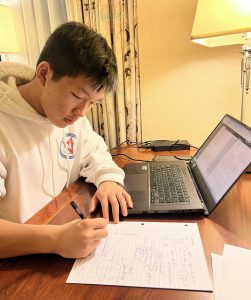After filling out a lengthy application, which includes a research paper and several essays regarding the applicant’s background, on Jan. 10, 300 students were recognized as semifinalists for the Regeneron Science Talent Search (Regeneron STS).
According to the official website, it is “the nation’s oldest and most prestigious science and math competition for high school seniors.” This year, seven Jefferson students were recognized in the top 300 Regeneron STS scholars: Kunal Bham, David Cao, Seoyoung Jun, Rohan Kalahasty, Ryan Kim, William Zhang and Brian Zhou.
Senior Seoyoung Jun’s submission to the Regeneron STS was part of a science fair project from sophomore year, which was a device that was able to recognize the space around it for the visually impaired.
“I used a 3-D depth sensor and then I made my own tactile display to display the information of the surrounding space. With that, I added [another] component which was object identification using machine learning,” Jun said. “Regeneron STS doesn’t have guidelines [on when the research has to be conducted], so I combined the research that I did from sophomore year and new research that I did during senior year.”
Cao’s research project covered the implications of ‘Oumuamua, the first interstellar asteroid detected in this Solar System, on panspermia, which is the hypothesis that life exists throughout the Universe, distributed by objects in space such as space dust, meteoroids and asteroids, as well as spacecraft carrying microorganisms.

“’Oumuamua was an interstellar asteroid that flew by [our] solar system in 2017, and it was special because it was [the first] interstellar object that ever flew by our solar system that we ever observed,” Cao said. “Panspermia is a theory for the origin of life. It’s basically [saying that] life started on Earth from the bombardment of interstellar asteroids that originally carried life, like bacteria.”
As this subject is about life spreading throughout our universe, it is impossible to accurately model or test it using current technology. So, Cao’s project was theoretical rather than experimental.
“It’s a little bit controversial in the astrophysics [and] astrobiology community, but I think my research will help provide more insights into the field of what is called panspermia,” Cao said. “We don’t know how life sparked on Earth, so even though panspermia may seem unlikely, it is beneficial to keep an open mind about it.”
By using ‘Oumuamua’s physical properties as a data point to create mathematical models, Cao determined how likely it is that panspermia sparked life on Earth and how many planets could harbor life.
“Based on that, you can calculate how likely it is that panspermia sparked life on Earth which, I found, was pretty [unlikely], it was 10^-5, which is around 1 over 100,000,” Cao said. “Assuming all conditions are the most optimistic and all other factors equate to one that number is around 10 to the 5 so 10,000 you know habitable worlds in our galaxy that may harbor life.”
Additionally, another Regeneron STS semifinalist, senior Kunal Bham’s, research project was about Prader-Willi syndrome, which is a rare genetic disorder that causes obesity.
“Right now, people don’t know what is causing Prader-Willi syndrome. [We know there’s] a region in the chromosome that is impacted, but they don’t know how that is causing the phenotype of Prader-Willi syndrome,” Bham said. “I looked at expression data in Prader-Willi syndrome and control and building protein networks to try mapping how each protein interacts with each other, and how they interact and the control and saw if there were any interactions that were different.”
The 40 finalists will be announced on Jan. 24. The finalists will receive the opportunity to take part in a week-long competition in Washington, D.C. in March.
“I don’t know [if I’ll get into finals] but I’ll stay hopeful,” Jun said.



![Senior Seoyoung Jun solders the board for her device as a part of her project. “I was like, 'What aids are there on the market that they use?' And I found that compared to [a lot of] other common [conditions], there wasn't much done for them,” Jun said. “It was a lot of the same technology that was used 30 years ago. So, I was like, 'I [should] try to develop something,' so I decided to develop a portable device. And then, I designed a little device that could help them recognize 3-D space.”](https://www.tjtoday.org/wp-content/uploads/2024/01/416848894_754539082786396_6815936047694996567_n-1200x1110.jpg)